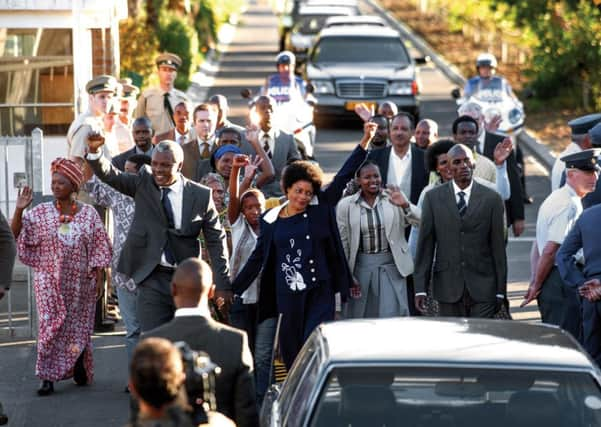Creating a film out of a long and inspiring lifetime


THE spectre of a long-dead child haunts the new Nelson Mandela biopic. It is the ghost of Stompie Moeketsi, the 14-year-old activist and suspected police snitch who was murdered on New Year’s Day 1989.
Yet Stompie doesn’t appear in Mandela: Long Walk to Freedom. Like many other characters, situations and scenarios he has been condensed, ellipsed or alluded to in order to concertina 70-plus years into 139-minute movie.
Advertisement
Hide AdAdvertisement
Hide AdWriter William Nicholson, the man behind Shadowlands, Gladiator and Les Misérables, freely admits he faced “an absolute nightmare” trying to shoehorn all the vital elements of Nelson Mandela’s personal and political life into the film.
Some things had to go. Stompie was one of them. Yet his killing at the hands of the Mandela United Football Club – the retinue of strong-arm bodyguards loyal to Winnie Mandela – has long been a cause celebre in South Africa.
And the finger of suspicion has long pointed towards Winnie who, in her husband’s absence, became a fearsome and, some claim, power-crazed, figure whose thugs terrorised Soweto.
When the case came to trial Winnie Mandela was found guilty of kidnapping and being an accessory to the assault of Stompie Moeketsi. She was handed a six-year jail sentence later reduced on appeal to a fine and a two-year suspended sentence.
Advertisement
Hide AdAdvertisement
Hide AdThis, many feel, was the turning point in the Mandelas’ relationship. They split in 1992 – two years after his release from prison. For Nelson Mandela, life in prison had bred a mood of reconciliation. For his wife, deprived of her husband, life had taken a radical and violent swing.
If the issue of Stompie’s murder is not addressed in Mandela: Long Walk to Freedom could criticism be levelled at the film and its creators that it is an airbrushed “authorised version” of the truth, and therefore not the truth at all?
William Nicholson considers the question and answers forcefully.
“There’s nothing that I’ve sought not to put in,” he says.“Nobody at any point said ‘Don’t put this in’. The Stompie story is so complicated and takes up so much time that to get into that is just a storytelling problem. That’s why it’s not there. There’s nothing that I’ve left out in order to give an authorised version.”
Advertisement
Hide AdAdvertisement
Hide AdHe adds that the Stompie story is addressed via a scene in which an informer is “necklaced” – burned to death by having a blazing tyre put around his neck.
“Winnie is telling people to do it and they do it. So I wanted very much to show that that did happen.”
Nicholson began writing his script in 1997 and got through 33 drafts. One early version started in prison and flashed back. Another told only the second half of Mandela’s life. Two years before the film was made, the screenplay ended with Mandela’s release from prison. Little by little he whittled it down removing by his own admission “an amazing mass of stuff’.
“At the end of the day we’re making a drama – a story that works in one film. It’s not a 20-part documentary. Then I realised that this was the Nelson and Winnie story. That demands going through to its sad and in some ways tragic ending.”
Advertisement
Hide AdAdvertisement
Hide AdTo create a mighty portrait the film demanded the intersecting of several key factors. They include script, director, star and finance. Three were in place. One was not. Who would play Nelson Mandela?
“I’d met every famous black actor you could think of. We had a session with Will Smith, Denzel Washington, Morgan Freeman, all of them. They hadn’t been rejected by us; they had become unavailable to us. It’s very difficult to nail down a big star.
“When Justin Chadwick the director came on board we decided not to wait for a big star; the big star is Mandela. So he started looking at the level below.”
That stratum of actor included 41-year-old Londoner Idris Elba, best-known as drug lord Stringer Bell in The Wire. Chadwick met Elba in New York where he was filming and returned having found his Mandela.
Advertisement
Hide AdAdvertisement
Hide Ad“I don’t know if you know about the real Mandela,” says Nicholson. “He’s 6ft 3ins, he was a boxer, a big strong charismatic guy. We think of him as a little shrunken old man. Not at all. So Idris actually fits him physically although he doesn’t actually look like him. When I saw Idris start work I was completely bowled over. Completely.
“He’s under three feet of make-up and still the humanity is right there.”
Nicholson was speaking ten days before Mandela died, aged 95.
Asked what would happen in the event of the great man’s death, he was cautiously optimistic for the future of South Africa.
Advertisement
Hide AdAdvertisement
Hide Ad“There will be a time of national re-examination when he dies. In a way his magic has long faded and they have a lot of problems. I’m optimistic. Many people are not. That was the past. They need to let go and find the new way of going forward. My belief is that they will.”
Films of the Mandela story
Mandela: Long Walk to Freedom is the latest biopic to focus on Nelson Mandela and it is the first one fully based on the autobiography of Mandela himself.
Previous versions in which the story of Nelson Mandela have been told include Goodbye Bafana and Mandela.
Idris Elba is widely tipped to receive an Oscar nomination for his performance as the South African leader. Morgan Freeman also received a nomination for his take on Mandela in Invictus but lost out to Jeff Bridges for Crazy Heart. In the film Elba ages from 25 to 76. In real life he was 40 when he filmed the movie.
On general release now.